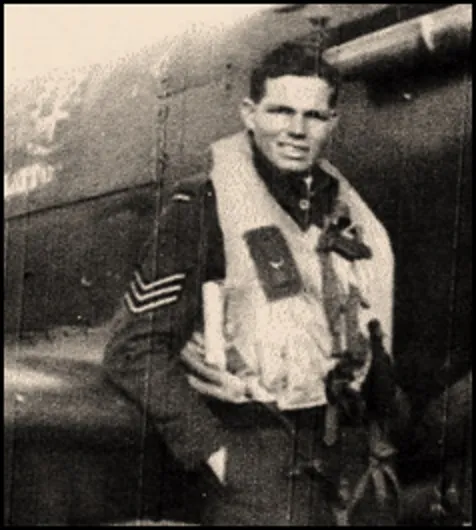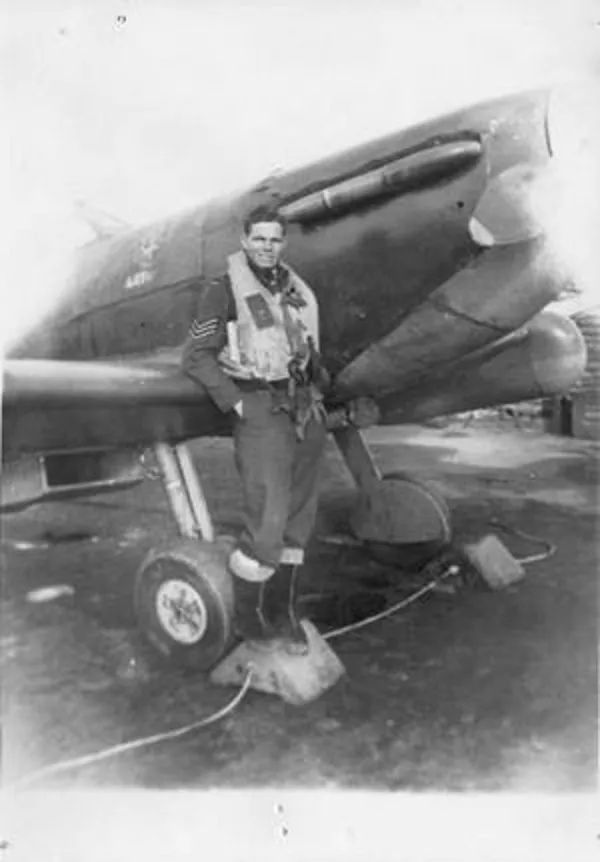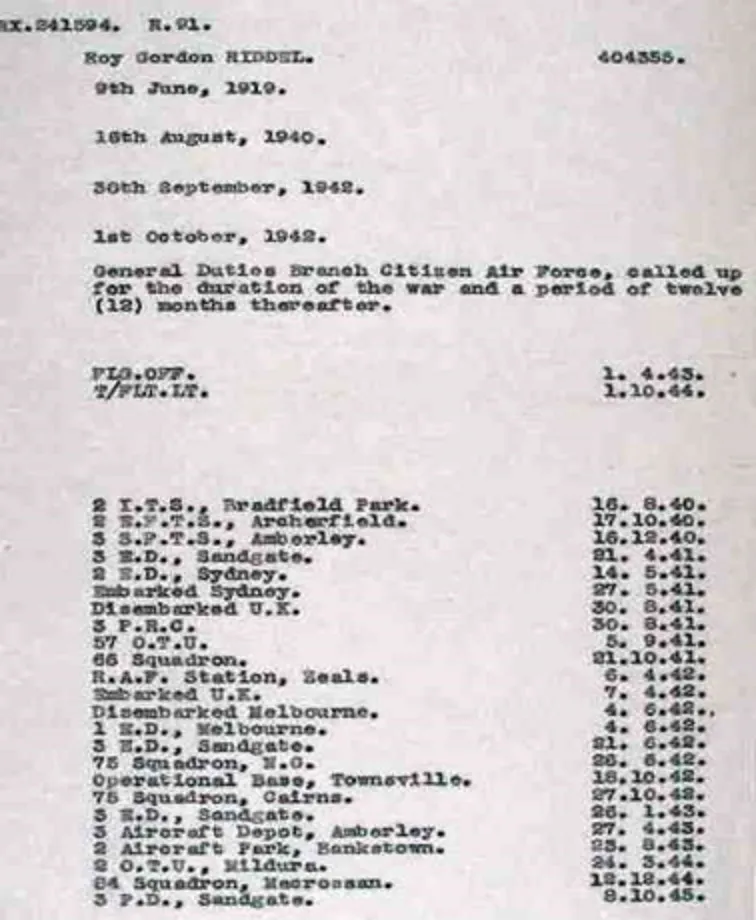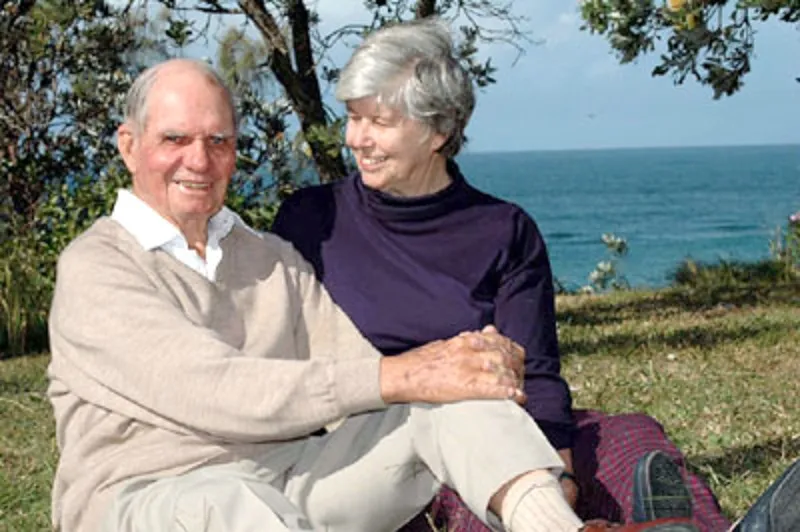FLTLT Roy Gordon Riddell 404355
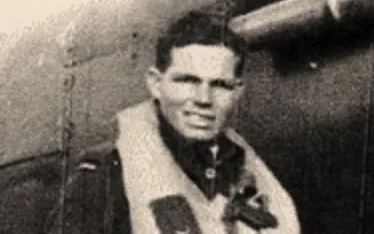


| Squadron/s | 75 SQN 84 SQN |
| Rank On Discharge/Death | Flight Lieutenant (FLTLT) |
| Mustering / Specialisation | Pilot |
| Date of Birth | 09 Jun 1919 |
| Date of Enlistment | 16 Aug 1940 |
| Contributing Author/s | David Knox, Robert Hamilton and Steve McGregor Updated by Vince Conant September 2103 The Spitfire Association |
Roy was born on the 9/6/1919 in Brisbane Queensland. He enlisted into the RAAF on the 16/8/1940.
Roy Riddel, remembered every detail of every plane he ever flew.
Roy Riddel's question about his wartime foes, "They cut my mate's head off. They didn't have to do that, did they?" was direct and discomfiting, but it said much about the man.
A formidable man with a booming laugh and a mischievous sense of humour, Riddel had little time for cant. He flew fighters in World War II and survived to marry, raise four children and build a dentistry practice in Coffs Harbour. Whether he ever forgave his foes is something people close to him may know.
While a child's smile or tears could soften him in an instant, Riddel could also be tough, unsurprising considering what he went through in Papua New Guinea.
"If someone came on to my property unlawfully I could shoot them, couldn't I?" he once asked after a nephew and mates had turned up unannounced at his house overlooking Korora Bay, just north of Coffs.
Roy Gordon Riddel was the son of a Morningside Shire clerk, John Riddel, and his wife, Gertrude, and was educated at Brisbane's Church of England Grammar School. In his final two years he played inside centre for the first XV and showed great potential but in later years he never spoke of it, so perhaps his war experience put a struggle on a sporting field into perspective.
Riddel had flown in 1931 with his father in a Genairco. It was a memorable experience so, when the war broke out, he joined the Empire Training School and became a pilot.
He first trained on Tiger Moths at Archerfield and later on Wirraways at Amberley. In 1940, with only a few months' experience, he set out on the ship Sarpeden for Europe and the war.
He and his mates flew Spitfires and accompanied bombers such as Whirlwinds, Halifaxes and Lancasters over western France. Riddel was once hit by a Messerschmitt. He made it back to England but his engine overheated and stopped on his final approach. He managed to land on the grass in front of the airstrip; the beach in front had been mined.
One day, returning from a patrol off the Scilly Isles with his tanks running low, it occurred to Riddel that he had not heard from ground control for quite some time. Checking his compass, he discovered that he was heading west for New York, not east for his base. He turned round in time and managed to get back but the engine stalled as he was taxiing in.
In 1942 Riddel was posted back to Australia, where he joined the RAAF 75 squadron. He was sent to Milne Bay where, for six weeks, the pilots saw constant action against Japanese Zeros. In December 1942 Riddel was coming in to land when his brakes jammed and the plane turned over. He broke his neck and carried the consequences for the rest of his life. The ground forces and airmen who survived the battle of Milne Bay were particularly proud. This was the first decisive battle against the Japanese Army and it had been fought almost exclusively by Australian forces.
By March of 1943 he had joined a test flight at Amberley. In all his service career Riddel was proud to have flown five models of Spitfire, four Kittyhawks, a Battle, a Boomerang, three types of Vengeance, a P38. He could always remember every detail of every plane he ever flew.
At 23, Riddel returned to Brisbane in a Spitfire VIII and put on a display of aerobatics his father would never forget. Flying over the East Brisbane bowling club at about 700 kmh, he did two upward rolls.
He was later posted to Mildura as an instructor and taught air-to-air combat and formation flying. At the end of this mission he was offered a job as a test pilot but preferred to return to active service.
He was sent to 84 Squadron at Townsville where he first flew the P51 Mustang, which he considered the best fighter plane of that era. He was later attached to 78 Squadron, where he achieved the rank of acting squadron leader, a proud moment in his life. He was discharged on the 21/11/1945.
After the war Riddel studied dentistry at the University of Queensland and practised briefly in Sydney and then in Coffs Harbour for more than 30 years. He continued to fly for pleasure until he was 80.
Roy Riddel, who has died at the age of 88, is survived by his second wife, Judy Bowen, and his children John, Susan, Robert and David. His first wife Joyce Knox - they married on leave in 1944 - died in 1971.
Aircraft/Accident Record:
A29-153 P-40E-1 41-24789 8/42 Served with 75 Sqn, 82 Sqn and 2 OTU; on 3/9/42 it was issued to 76 Sqn from 12 RSU; on 19/9/42 it was with 75 Sqn and may have been with them most of the month; on 14/11/42 it swung off the strip into soft ground and nosed over with pilot SGT Roy Gordon Riddel escaping injury; on 4/12/42 it was returned to 75 Sqn at Milne Bay, NG and early in 1943 it was coded 'O' and had "Grace" on both sides of the cowling; on 14/4/43 it had its port wing damaged in a landing accident with A29-118 when the latter landed in the opposite direction to this Kittyhawk due to A29-118 being low on fuel after a big engagement with the enemy [pilot?]; on 1/5/43 it was returned to 75 Sqn from 10 RSU; on 2/11/43 it was received by 82 Sqn from 75 Sqn; on 17/4/44 it was received by 2 OTU from 82 Sqn; on 5/10/44 it was involved in a line astern chase when the a/c dived into the ground from 6,000ft killing P/O Thorburn Harcourt MacGowan (435754) and the a/c was found on a property near Mildura, Vic.Aircraft/Accident Record:
A29-131 P-40E-1 41-36082 6/42 served with 75 Sqn; on 21/6/42 it was received by 75 Sqn from 2 AP and served with 75 Sqn through the Battle of Milne Bay and was coded 'H' with them; on 13/12/42 it overturned on landing at Bowen Qld injuring SGT Roy Gordon Riddel (404355) and was sent to 12 RSU; on 9/9/43 approval was given to convert to components after spending all year at 12 RSU and 5 AD.